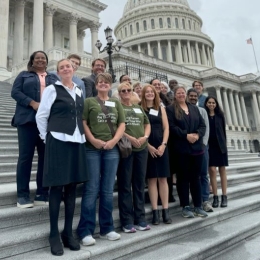The COVID-19 pandemic has placed extraordinary stress on the charitable food system—the network of food banks, food pantries, and other meal programs—and provided an overdue wakeup call about the risks and costs of food insecurity and diet-related disease in this country.
In 2020, 60 million people turned to charitable food assistance and food banks are serving 55 percent more people than before the pandemic. And we now know that people living with diet-related diseases like type 2 diabetes are more likely to get severely ill or die from COVID-19.
The double burden of food insecurity and chronic disease is as much a public health issue as it is an equity issue. Adults and children in food insecure households are at greater risk of developing chronic disease and illness than adults and children in food secure households. And due to discrimination and structural racism, food insecurity and associated chronic diseases disproportionately affect racial and ethnic minorities. Alarmingly, while the national food insecurity rate of 10.5 remained constant from 2019 to 2020, the rate increased for Black households, Hispanic households, and households with children.
It’s imperative that our country’s food safety net programs ensure equitable access to nutritious food. While food banks are meant to be a last resort, secondary to programs like the Supplemental Nutrition Assistance Program (SNAP) and the Special Supplemental Nutritional Program for Women, Infants, and Children (WIC), benefit levels and coverage in these programs are often inadequate. For example, 58 percent of SNAP clients who are also using food pantries visit those pantries frequently to more fully meet their food needs. Many people have little choice but to turn to charitable food assistance.
A 2018 report found that, on average, 25 percent of food bank distributions remain unhealthy. Many food banks have adopted nutrition policies to encourage healthier donations and discourage donations of “junk food,” like candy and soda, and one in seven formally ban certain unhealthy items. But even food banks with formal bans still struggle with unwanted donations and insufficient donations of nutritious food. Food bank clients aren’t receiving enough of the items they want, like fresh produce, meat, and dairy.
In response, CSPI is investigating how changes to both public policy and corporate practices can improve the nutritional quality of food bank donations and distributions.
On the public policy front, we recently published policy approaches to healthier food banking, a report finding that only 43 of 295 federal and state laws, regulations, and administrative decisions affecting food donation to the charitable food system prioritize nutrition. The report makes recommendations for federal and state level policy reforms to improve the nutritional quality of these donations.
We also recently released healthier food donation guidelines for retailers and distributors, a corporate resource that helps food retailers and distributors create donation programs that prioritize nutritious, fresh, and culturally relevant food and beverages.
We welcome the chance to work with corporations and legislators to help families turning to the charitable food system get quality, nutritious food that meets their needs. Consumers can advocate for healthier food banking by talking to their local grocery store manager about donations and working with their local elected officials to pass healthier food banking policies.







